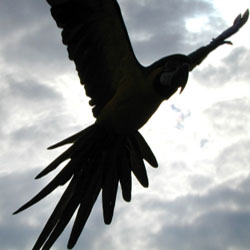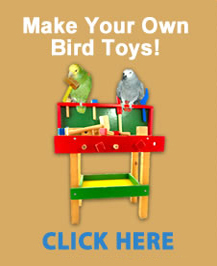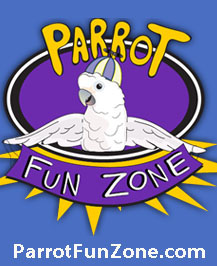- Written by: Deb White
- Category: Safety
 There may come an unfortunate time when your parrot companion is lost or stolen. There are several steps you can take to prevent theft or loss.
There may come an unfortunate time when your parrot companion is lost or stolen. There are several steps you can take to prevent theft or loss.
Be Prepared
If your bird is stolen or flies away, every minute is of the essence and even a few minutes might make the difference in whether your bird is recovered. Taking steps to prepare for this type of occurrence will help you react more quickly and will also help you be prepared to react in the event of manmade or natural disaster.
- Keep proof of ownership records.
- Make a record of your bird's leg band ID.
- Have several recent color photos of your bird on hand.
- Have a digital photo ready to go for a lost bird flyer, or even better...
- Draft a flyer complete with a photo on your computer containing all your pertinent contact information that can be quickly updated with last minute specifics regarding the loss (date, location, etc).
- Microchip your bird for ID purposes. This is a small device inserted under the skin. A scanner can then be used to retrieve your bird’s information.
Loss Prevention
The following simple preventative measures will go a long way towards preventing your bird from flying away:
- Keep your birds wings clipped. Be especially vigilant in the summer months when doors and windows are often open.
- Don't assume your bird won't take off. Even a bird who is content to remain on your shoulder 24/7 will take off if startled by a loud noise or a dog jumping up at them.
- When you take your bird outside, always keep them in a carrier or wearing a flight suit/harness.
- Make sure your birds outside cage or aviary has secure locks.
- Teach your bird your address and phone number.
Theft Prevention
The states with the highest rates of bird theft are Florida and California. Large parrots are the birds most often targeted. The following tips will help you avoid being victimized by a potential bird thief:
- Keep birds out of windows that can be viewed and easily accessed by the public.
- Should you take your bird out in public, beware that someone might follow you home.
- Don't give out personal information or your phone number to strangers who know you have exotic birds.
- Don’t discuss your home security with anyone.
- Put motion detector lights outside your home.
- Keep your windows and doors locked.
If Your Bird is Lost or Stolen
Domestically raised parrots typically don't have the requisite skills to survive for long periods in the wild. However, depending on the climate, availability of food (fruit trees, vegetable gardens, bird feeders) and the level of exposure to predators they have been known to survive several days to years.
There are several steps you can take to increase the likelihood of recovering your bird:
- Place a cage with food and water on the roof or in a tree.
- Tell everyone in your neighborhood and enlist help in spotting your bird, making phone calls and distributing posters.
- Notify the following organizations as soon as possible:
- Police
- Animal Control
- Humane Society
- Vet Clinics
- Pet Stores
- Local bird clubs
- Rescue Organizations
- Make and place brightly colored posters in the following locations:
- around your neighborhood
- grocery stores
- pet stores
- schools
- churches
- libraries
- Place ads in your local newspapers
- Watch the ads in the local paper to see if someone has found or may be trying to sell your bird.
- Place listings on websites dedicated to recovering lost pets:
- Birds are most vocal just before sunrise and just after sundown so these are especially good search times.
- Make familiar calls to your bird and listen for a response.
- If your bird is spotted in a tree, enlist help in keeping a watch on him until you can effect a rescue.
- Don't give up!
- Written by: Deb White
- Category: Safety

Plants can certainly liven up your home and your bird's environment and they are also very beneficial towards reducing indoor air pollution. Many plants however are dangerous for birds and care must be taken to ensure that you only accentuate your home using plants that are deemed safe for pet birds.
The following is a list of plants, flowers and trees reported to be bird safe:
| Abelia | Danish Ivy | Moses-in-the-cradle |
| African Daisy | Date | Mother Fern |
| African Violet | Day Lilies | Mother-in-law's tongue |
| American or European Beech | Devil's Ivy | Nasturtium |
| American Bittersweet | Dill | Natal plant |
| Aloe | Dogwood | Nerve plant |
| Aluminum Plant | Donkey Tail | Norfolk Pine |
| Arbutus | Dracaena | Oregano |
| Areca Palm | Dragon Tree | Pansies |
| Ash | Easter Cactus | Parlor Palm |
| Asparagus Fern | Echeveria | Parsley |
| Aspen | Elderberry | Passionflower |
| Aspidistra | Elephant Foot Tree | Peppermint |
| Australian Laurel | Elk's Horn | Pepperomia |
| Autumn Olive | Elm | Petunia |
| Baby's Breath | Eucalyptus | Pine (Ponderosa, Spruce, Virginia or White) |
| Baby's Tears | Eugenia | Pineapple |
| Bachelor Buttons | European Fan Palm | Pony Tail Palm |
| Bamboo Palm | Fiddle Leaf Fig | Poplar, White |
| Barberry | Fig Plant | Pothos |
| Begonias | Fir (Balsam, Douglas, White) | Prayer Plant |
| Bird's Nest Fern | Flame Nettle | Purple Passion |
| Bladdernut | Garden Mum | Purple Velvet |
| Blood Leaf Plant | Gardenia | Pyracantha |
| Blueberry | Garlic | Oregano |
| Borage | Gladiolus | Raphiolepsis |
| Boston Fern | Gloxinia | Raspberry |
| Bottle Brush Fern | Gold Dust Dracaena | Rose |
| Bougainvillea | Grape Ivy | Rosemary |
| Brake, Ribbon, Dish | Grapevine | Rubber Plant |
| Bromeliads | Hawaiian Scheffler | Rubber Tree |
| Calamint | Hens and Chicks | Russian Olive |
| Calendula | Hibiscus | Sage |
| California Holly | Hollyhocks | Scented Geranium |
| Camellia | Honeysuckle | Schefflera |
| Canary Island Palm | Hoya | Sensitive Plant |
| Carnation | Huckleberry | Spruce (Black, Norway, Red or White) |
| Chamomile | Impatients | Squirrel's Foot Fern |
| Chickweed | Indian Hawthorne | Star Jasmine |
| Chicory | Indian Laurel | String of Beads |
| Chives | Jade PLant | Swedish Ivy |
| Christmas Cactus | Kalanchoe | Sword Fern |
| Cissus (kangaroo Vines) | Kangaroo Vine | Thistle |
| Claw Cactus | Lace Fern | Ti Plant |
| Coffee Tree | Lady Palm | Tulip Thyme |
| Comfrey | Larch | Thyme |
| Coralberry | Lavender | Umbrella Tree |
| Corn Plant | Lemon Balm | Velvet Nettle |
| Cotoneaster Firethorn | Lilac | Viburnum |
| Cottonwood | Lily | Viola |
| Crabapple | Maidenhair Fern | Violet |
| Creeping Fig | Magnolia | Wandering Jew |
| Creeping Jeremy | Manzanita | Wax Plant |
| Croton (house variety) | Marigold | Willow |
| Dahlia | Mayapple | Yucca |
| Daisies | Ming Fern | Zebra Plant |
| Dandelion | Monkey Plant | Zinnia |
Please note that any "safe plant" is rendered unsafe as soon as it has been exposed to pesticides. It should also be noted that indoor fertilizers also present a health hazard to your bird if ingested.
If you have a question regarding the safety of a specific plant ask your veterinarian, local green house, or the Animal Poison Control Center (AAPCC).
Click here for a list of Poisonous Plants.
Write comment (0 Comments)
- Written by: Deb White
- Category: Safety
 As with kids, no toy is 100% safe for all birds. A parrot relies on its owner to make sure its playtime activities are safe. Selecting the right toy is one way you can keep your bird healthy and injury free. There are several factors that must be considered in making a safe toy selection for your bird:
As with kids, no toy is 100% safe for all birds. A parrot relies on its owner to make sure its playtime activities are safe. Selecting the right toy is one way you can keep your bird healthy and injury free. There are several factors that must be considered in making a safe toy selection for your bird:
- Size appropriateness
- Construction of the toy (materials, design)
- Knowledge of your bird's individual toy personality and play style.
Size Considerations
Any toy has the potential to be unsafe if improperly sized to the bird. For example, a toy meant for a small bird is often constructed with components that could pose choking hazards to large birds and, conversely, toys meant for larger birds could pose a risk of entrapment. Small brittle plastic parts may be perfect for a little bird but could easily shatter into sharp splinters when subjected to the power of a large bird's beak.
Construction Aspects
A toy that is 100% safe for one bird may pose a risk to another bird. Both design and material suitability must be assessed by a bird owner.
Design
Poorly designed toys can present a risk of injury to your bird. Some questions to keep in mind are:
- Are there loops of a size that your bird is at risk for getting his head stuck in?
- Are there small openings that could pose a risk of toe or nail entrapment?
- Is there a long length of exposed rope, leather or chain that could pose a risk of strangulation if the bird tosses the toy and it wraps around its neck?
- Is the type of hardware used appropriate to the size of the bird the toy is designated?
- Are there any small parts, if removed, that could cause soft tissue injury to your bird's mouth? (i.e., screws, eyes, small wires)
Materials
Reputable manufacturers choose to use only the safest components in the construction of their toys. However, materials that are completely safe for a budgie may be extremely hazardous to a large bird. It is important to know what safety issues must be considered relative to the materials commonly used in toys
Wood
- Make sure the wood used in your toy is from a "safe" tree.
- Safe woods (partial list) include: Pine, Balsa, Bamboo, Beech, Birch, Basswood, Cajeput, Dogwood, Douglas Fir, Hickory, Poplar, Maple, Walnut, Ash, Apple, Elm, Cactus (Cholla) and Manzanita.
- Unsafe woods (partial list) include: Cedar, Cherry, Plywood and Oak.
- Make sure the wood is colored only with non-toxic food coloring or vegetable dyes.
- If you are interested in a toy with painted parts (i.e., ABC blocks) make sure that only non-toxic, child safe paints were used.
Rope
- Only 100% natural fiber ropes such as cotton, hemp, jute or sisal should be used in bird toys.
- Rope toys can be safe as long as they are maintained properly and the bird’s beak and nails are kept trim.
- Bird owners have a responsibility to check their bird's rope toys daily and to cut back or discard rope toys when they become frayed or present a hazard to their bird.
Chain
- Chain should have welded not open links. Un-welded chain provides sharp surfaces and narrow openings which have been known to cut toes.
- Make sure the links are a safe size for your bird. If a bird's toes get caught in the links the result can be a broken nail, toe or leg.
- Chain length is also a consideration. A long length of chain could conceivably end up wrapped around a bird’s neck during a vigorous play session. As the wood components are chewed off, a chain hazard could develop.
Fasteners
- Never purchase toys that use split key rings, spring loaded clips or metal shower rings as fasteners.
- Small hardware pieces can be ingested accidentally or cause mouth injuries.
- Quick-link or Pear link type connectors are recommended to attach toys to the bird's play area. This type of fastener provides the least potential for injury.
Plastics
- When considering toys with plastic components a bird owner must consider the nature of the plastic component (i.e., soft vs. brittle) relative to the size of the bird.
- Brittle plastics should not be given to larger birds because when they break very sharp, cutting edges are formed and if swallowed accidentally could result in ruptured organs.
- Hard plastic toys specifically designed for parakeets and cockatiels should not be given to larger birds.
Leather
- Only vegetable tanned leather should be used on bird toys.
- Do not buy toys with dyed leather or leather tanned with chemicals as most are toxic to birds (i.e., chromium, formaldehyde). For this reason you should not retire old shoes, belts and pocketbooks to your birds toy chest.
- Replace leather if soiled or wet. Bacteria will flourish under these conditions.
- When hanging toys strung on leather (or rope or chain), avoid leaving a long strand between the toy and the cage. Some birds, when rambunctious with their toys, can get the leather wrapped around their necks and strangle. It is best to tie the toy close to the bars of the cage.
Rings
- When choosing toys with rings or large plastic chain links, make sure that the rings are of a size that the bird can’t get his head stuck in the rings and choke.
- Also, beware of toys with multiple rings looped directly together, as birds have met similar fates when they have been trapped between the rings.
Bells
- If a bird is mechanically inclined and can remove the bell clapper, the potential exists for swallowing/choking.
- Make sure the bell clapper can not be removed by the bird. If it is not securely fastened remove it.
- Make sure the clapper is not lead (toxic). If it is lead, you will be able to dent the clapper with your fingernail.
- Do not buy toys that use jingle type bells, toes can become caught and cut in the wide to narrow openings. We recommend the cow or liberty bell designs.
- Appropriately size the bell to the bird so it will be able to withstand the power of the beak.
Observation & Knowledge of Your Bird
Ultimately, only a bird owner can determine whether a toy is suitable for their bird based on the close observation and knowledge of their bird's interaction with toys. Studying your bird while they are playing will help you to choose toys well suited to your bird's individual personality and play style.
Supervision is the absolutely best defense against a toy related injury.
Use common sense and supervise your bird when you first give him a new toy. Observe how he interacts with the toy to determine how best to hang it and where and when to allow him to play with it (some toys are safer outside the cage).
If in doubt, take it out!
If your bird is extremely aggressive with his toys and puts himself at risk of getting bopped in the head or wrapping it around his neck then maybe hanging toys are not the best for use within his cage when no one else is there to supervise. Bolt-on toys are a good alternative in this instance.
Summary
Toys are critical to your parrot's well-being and serve as a substitute outlet for the many activities they would engage in daily, in the wild. Although no toy is 100% safe, don't let your concerns over safety overwhelm your thinking. You can ensure your bird's safety by taking a reasoned approach. The critical steps towards ensuring success are to:
- Evaluate a toy's suitability before purchase based on the criteria presented above.
- Examine the toy upon receipt to ensure that there are no dangerous defects (i.e., sharp edges, broken welds)
- Observe your bird's interactions with his new toy and determine whether he can continue to play with the toy unsupervised.
- Inspect your bird's toys daily to ensure that their condition remains safe and make repairs as necessary. Owners must monitor the status of toys and ensure that as they physically change, safety hazards do not develop (i.e., through fraying, exposure of rope due to chewed off parts, etc.) For advice on how to clean your bird's toys check out Cleaning Your Bird's Toys and Accessories.
- Maintain your bird's nails and beak to minimize the potential for entrapment. For further guidance regarding grooming check out our articles Beak Bytes and Nail Nibbles.
Write comment (0 Comments)


















































































































































